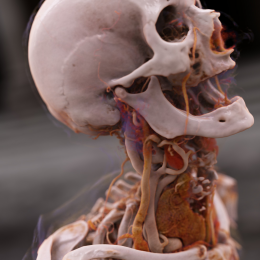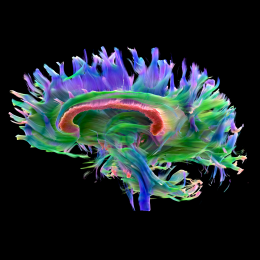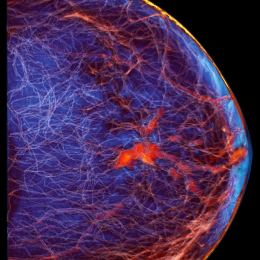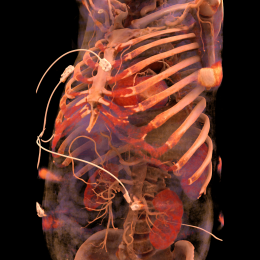News • Cinematic Rendering
Siemens visualization experts nominated for 2017 German Future Prize
Siemens Healthineers employees Dr. Klaus Engel and Dr. Robert Schneider have been nominated for the German Future Prize along with Professor Franz Fellner, MD, for the development of the visualization technology Cinematic Rendering.
They are one of three research teams in contention for the award. The prize, awarded by the President of Germany, is one of the country's highest distinctions for technology and innovation. Cinematic Rendering technology, developed by the two visualization experts and their clinical partner, generates photorealistic three-dimensional representations of the human body from the output of CT and MRI scans.
Using the radiological software Syngo.via and Syngo.via Frontier, the technique enables previously unseen levels of clarity. These striking new images simplify communication between physicians and patients or between radiologists and referring clinicians, help surgeons select the most appropriate surgical strategy, and open up new horizons in medical training. The German Future Prize will be awarded on November 29, 2017, by German President Dr. Frank-Walter Steinmeier in Berlin.
For many people, Cinematic Rendering offers the first real insight into what is going on inside their body
Bernd Montag
"The nomination of two of our leading visualization experts and one of our clinical research partners for the German Future Prize is a great honor for our company – and a testament to our sustained investment in innovation," said Dr. Bernd Montag, CEO of Siemens Healthineers. More than 12,500 patents are registered to Siemens Healthineers employees, while in the 2016 business year alone the company invested around a billion euros in research and development – a field in which it employs some 7,500 people.
Siemens Healthineers draws on a collaborative network comprising over 4,200 research partners all over the world. "Time and again, our close collaboration with clients and research partners has enabled us to pioneer groundbreaking innovations in countless areas of medical technology and quickly bring them to market, benefiting users and boosting efficiency in healthcare systems worldwide, but above all increasing patient well-being. For many people, Cinematic Rendering offers the first real insight into what is going on inside their body. This example highlights the broad range of opportunities originating from the digitalization of healthcare," Montag explains.
Inspired by film technology and the physics of light
Klaus Engel and Robert Schneider developed the new visualization technology taking inspiration from film technology, and refined it in collaboration with Franz Fellner. Cinematic Rendering provides unprecedented photorealistic clinical images by leveraging the physics of light. A specially developed algorithm simulates the complex interactions of elementary light particles (photons) with patient data from CT or MRI scans. Unlike animations in the film industry, where only the light reflected off the surface of the character's body is calculated, the algorithm developed by the Siemens Healthineers researchers also takes into account the light which penetrates the subject's tissue, where it is scattered in different directions. This results in hyper-realistic representations of fractures, organs or the structure of the finest blood vessels.
Since early 2017, users of the imaging software Syngo.via have been able to create photorealistic images from any CT or MRI scan. These images facilitate communication between physicians and patients, for instance to explain a planned operation, but also between radiologists and referring physicians. The photorealistic images can vividly illustrate the course of a fracture line or the growth of a tumor. This does not involve any additional radiation exposure, as rendering takes place entirely in the postprocessing stage with just a few mouse clicks. Cinematic Rendering also offers great potential in fields beyond radiology: For instance, the heightened clarity enables surgeons to prepare interventions in greater detail, reducing the risk of complications. The benefits offered by the technology in its various fields of application – including forensics – are currently being examined in detail in a number of studies at European university hospitals.
These innovative images from inside the human body are also a boon to medical students studying anatomy. However, the new resource will above all benefit the large numbers of non-physician medical personnel who have no opportunity to explore the human anatomy in dissection courses. For two years, Professor Fellner has been successfully using Cinematic Rendering both for further education of medical personnel and as an information tool for laypersons.
Source: Siemens Healthineers
13.09.2017















